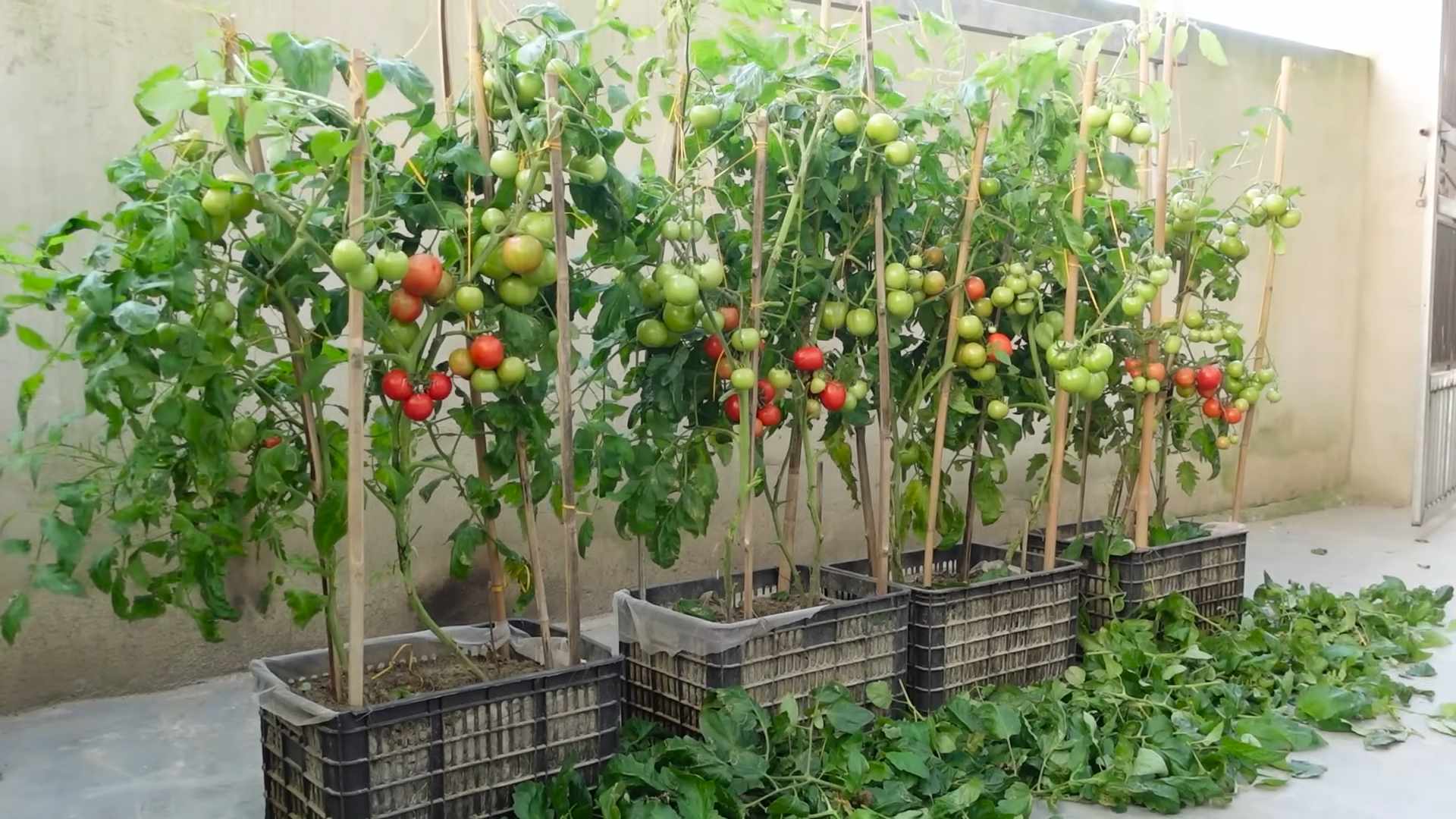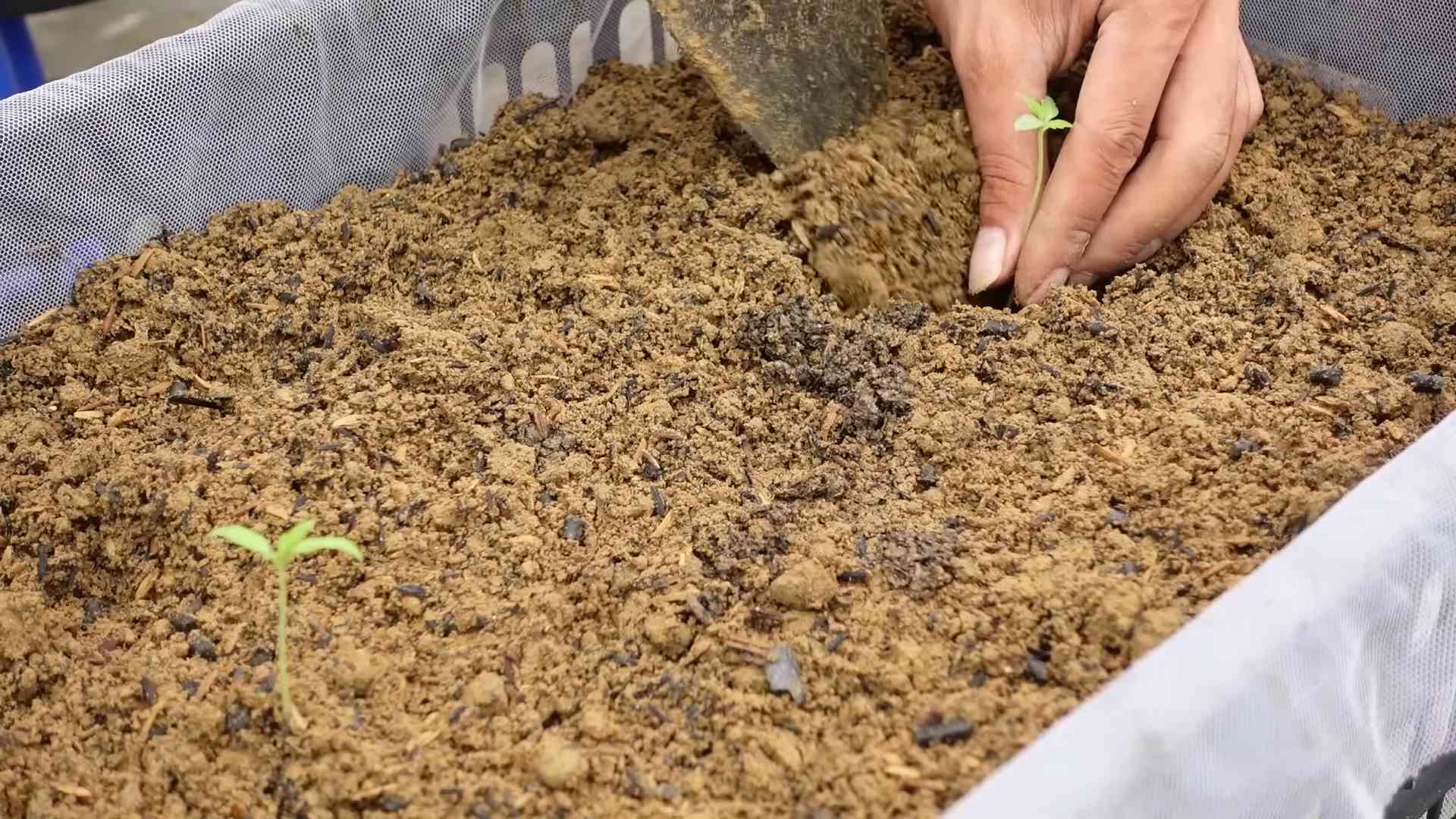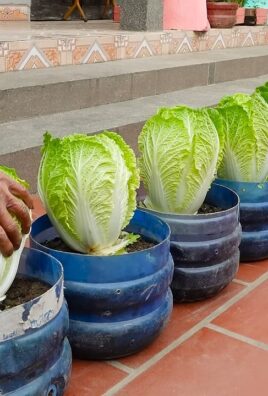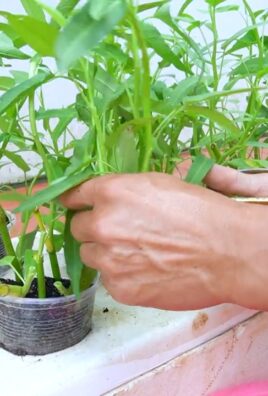Growing Tomatoes Indoors might seem like a far-fetched dream, especially if you don’t have a sprawling backyard. But guess what? It’s totally achievable, and I’m here to show you how! For centuries, humans have cultivated crops indoors, from ancient Roman greenhouses to modern-day vertical farms. This ingenuity stems from a deep-seated desire to nurture life and provide sustenance, regardless of external limitations.
Imagine biting into a juicy, sun-ripened tomato in the dead of winter, all thanks to your own indoor garden. No more bland, store-bought tomatoes lacking that vibrant flavor! This DIY guide is your ticket to fresh, flavorful tomatoes year-round, regardless of your climate or living space. We’ll explore simple yet effective techniques to ensure your indoor tomato plants thrive, from choosing the right varieties to mastering the art of pollination.
Why is growing tomatoes indoors so appealing? Well, beyond the obvious benefit of fresh produce, it’s incredibly rewarding. It’s a chance to connect with nature, learn new skills, and enjoy the satisfaction of nurturing something from seed to fruit. Plus, it’s a fantastic way to add a touch of green to your home and boost your mood. So, let’s dive in and unlock the secrets to a bountiful indoor tomato harvest!

Growing Tomatoes Indoors: A Comprehensive DIY Guide
Hey there, fellow gardening enthusiasts! Dreaming of juicy, sun-ripened tomatoes even when the weather outside is frightful? Well, guess what? You absolutely can grow tomatoes indoors! It takes a little planning and effort, but trust me, the taste of a homegrown tomato in the middle of winter is totally worth it. I’m going to walk you through everything you need to know to successfully cultivate your own indoor tomato garden.
Choosing the Right Tomato Variety
First things first, not all tomato varieties are created equal when it comes to indoor growing. You’ll want to choose determinate or dwarf varieties. These types stay smaller and more compact, making them perfect for containers. Indeterminate varieties, on the other hand, can grow incredibly tall and require extensive staking, which isn’t ideal for indoor spaces.
Here are some of my favorite determinate and dwarf tomato varieties for indoor growing:
* Tiny Tim: These are super compact and produce adorable, bite-sized tomatoes.
* Roma: A classic choice for sauces and pastes, Romas are relatively easy to grow indoors.
* Patio: As the name suggests, Patio tomatoes are bred for container gardening and produce a good yield.
* Micro Tom: The smallest tomato variety, perfect for small spaces.
* Bush Early Girl: A reliable and early-producing variety.
Gathering Your Supplies
Okay, now that we’ve picked our tomato stars, let’s gather the necessary supplies. Here’s what you’ll need:
* Tomato seeds: Obviously! Choose your preferred variety from the list above.
* Seed starting tray or small pots: For starting your seeds indoors.
* Seed starting mix: A light and airy mix specifically designed for seed germination.
* Larger pots (5-10 gallon): These will be the final homes for your tomato plants.
* Potting mix: A good quality potting mix that drains well. Avoid using garden soil, as it can compact and not provide adequate drainage.
* Grow lights: Essential for providing the necessary light for healthy growth.
* Liquid fertilizer: A balanced fertilizer formulated for tomatoes.
* Watering can or spray bottle: For watering your plants.
* Small fan: To provide air circulation and prevent fungal diseases.
* Stakes or tomato cages: To support your plants as they grow (especially for slightly larger determinate varieties).
* Optional: Heat mat: To speed up germination.
Starting Your Tomato Seeds
This is where the magic begins! Starting your seeds indoors gives you a head start on the growing season.
1. Prepare your seed starting tray or pots: Fill each cell or pot with seed starting mix. Moisten the mix thoroughly.
2. Sow the seeds: Plant 2-3 seeds per cell or pot, about ¼ inch deep.
3. Cover the seeds: Gently cover the seeds with more seed starting mix.
4. Water gently: Water the seeds using a spray bottle to avoid disturbing them.
5. Provide warmth: Place the seed starting tray or pots on a heat mat (optional) or in a warm location. The ideal temperature for germination is around 70-75°F (21-24°C).
6. Maintain moisture: Keep the seed starting mix consistently moist, but not soggy. You can cover the tray or pots with a plastic dome or plastic wrap to help retain moisture.
7. Wait for germination: Tomato seeds typically germinate in 5-10 days.
8. Provide light: Once the seedlings emerge, remove the plastic cover and place them under grow lights. Position the lights a few inches above the seedlings and keep them on for 14-16 hours per day.
Transplanting Your Seedlings
Once your seedlings have developed a few sets of true leaves (the leaves that look like miniature tomato leaves), it’s time to transplant them into larger pots.
1. Prepare your larger pots: Fill the 5-10 gallon pots with potting mix.
2. Carefully remove the seedlings: Gently loosen the soil around the seedlings and carefully lift them out of the seed starting tray or pots. Be careful not to damage the roots.
3. Plant the seedlings: Dig a hole in the potting mix large enough to accommodate the root ball. Place the seedling in the hole and gently backfill with potting mix. You can bury the stem a little deeper than it was previously planted, as tomatoes can develop roots along the stem.
4. Water thoroughly: Water the newly transplanted seedlings thoroughly.
5. Provide support: Insert a stake or tomato cage into the pot to provide support for the plant as it grows.
Providing the Right Environment
Now that your tomato plants are in their final homes, it’s crucial to provide them with the right environment to thrive.
* Light: Tomatoes need at least 6-8 hours of direct light per day. If you don’t have a sunny window, you’ll need to use grow lights. Keep the lights on for 14-16 hours per day.
* Temperature: The ideal temperature for growing tomatoes is between 65-85°F (18-29°C). Avoid exposing your plants to temperatures below 55°F (13°C).
* Watering: Water your tomato plants regularly, keeping the soil consistently moist but not soggy. Water deeply when the top inch of soil feels dry. Avoid watering the foliage, as this can lead to fungal diseases.
* Air circulation: Good air circulation is essential for preventing fungal diseases. Use a small fan to circulate air around your plants.
* Fertilizing: Feed your tomato plants with a balanced liquid fertilizer every 2-3 weeks. Follow the instructions on the fertilizer label.
Pollinating Your Tomato Plants
Tomatoes are self-pollinating, but they often need a little help indoors. Without wind or insects to shake the pollen loose, you’ll need to hand-pollinate your plants.
1. Gently shake the plants: You can gently shake the plants a few times a week to help release pollen.
2. Use a small brush: Alternatively, you can use a small, soft brush to collect pollen from one flower and transfer it to another.
3. Use an electric toothbrush: Some people use an electric toothbrush (without toothpaste!) to vibrate the flowers and release pollen. Just gently touch the back of each flower with the toothbrush for a few seconds.
Dealing with Pests and Diseases
Even indoors, your tomato plants can be susceptible to pests and diseases. Here are some common problems and how to deal with them:
* Aphids: These tiny pests can suck the sap from your plants. You can control aphids by spraying them with insecticidal soap or neem oil.
* Whiteflies: Similar to aphids, whiteflies can also damage your plants. Use insecticidal soap or neem oil to control them.
* Spider mites: These tiny mites can cause yellowing and stippling on the leaves. Increase humidity and spray with insecticidal soap or neem oil.
* Fungal diseases: Fungal diseases like early blight and septoria leaf spot can be a problem in humid environments. Ensure good air circulation and avoid watering the foliage. You can also use a fungicide if necessary.
Harvesting Your Tomatoes
The most rewarding part! Your tomatoes are ready to harvest when they are fully colored and slightly soft to the touch. Gently twist the tomato off the vine. Enjoy your homegrown tomatoes in salads, sandwiches, sauces, or just eat them straight off the vine!
Troubleshooting Tips
* Yellowing leaves: This could be a sign of overwatering, underwatering, nutrient deficiency, or pest infestation. Check the soil moisture, fertilize your plants, and inspect them for pests.
* Blossom end rot: This is caused by a calcium deficiency. Ensure your soil has adequate calcium and water your plants consistently.
* Lack of fruit: This could be due to insufficient light, poor pollination, or extreme temperatures. Provide adequate light, hand-pollinate your plants, and maintain a consistent temperature.
Growing tomatoes indoors can be a fun and rewarding experience. With a little care and attention, you can enjoy fresh, homegrown tomatoes all year round! Don’t be afraid to experiment and learn as you go. Happy gardening!

Conclusion
So, there you have it! Growing tomatoes indoors might seem like a daunting task, but with a little know-how and the right approach, you can enjoy the taste of homegrown, sun-ripened (well, grow-light ripened!) tomatoes all year round. This DIY trick for growing tomatoes indoors is a game-changer for anyone who craves that fresh, vibrant flavor, especially during the colder months when garden-fresh produce is scarce.
Why is this a must-try? Because it puts you in control. You control the environment, the nutrients, and the overall health of your tomato plants. No more relying on store-bought tomatoes that lack that true, bursting-with-flavor taste. Plus, it’s incredibly rewarding to nurture a plant from seed to fruit, witnessing the miracle of nature unfold right in your own home.
But don’t stop there! Experiment with different varieties of tomatoes. Cherry tomatoes and dwarf varieties are particularly well-suited for indoor growing. Try different types of grow lights to see which yields the best results for your specific setup. You can also explore different soil mixes and fertilization schedules to optimize your plants’ growth and fruit production. Consider adding companion plants like basil or marigolds to your indoor tomato garden to deter pests and enhance flavor.
And remember, success with indoor tomato growing often comes down to patience and observation. Pay close attention to your plants’ needs, adjust your watering and lighting as necessary, and don’t be afraid to troubleshoot any problems that arise.
We’re confident that this DIY trick will transform your approach to fresh produce. Imagine the satisfaction of adding your own homegrown tomatoes to salads, sauces, and sandwiches, knowing that you nurtured them from seed to table.
So, what are you waiting for? Give this DIY trick for growing tomatoes indoors a try! We’re eager to hear about your experiences. Share your tips, tricks, and triumphs in the comments below. Let’s create a community of indoor tomato growers and learn from each other’s successes and challenges. Happy growing!
Frequently Asked Questions (FAQ)
Q: What are the best tomato varieties to grow indoors?
A: While you can technically grow any tomato variety indoors, some are better suited than others. Determinate or bush varieties, especially dwarf or micro-dwarf types, are generally recommended because they stay smaller and require less space. Cherry tomatoes, grape tomatoes, and Roma tomatoes are also popular choices for indoor growing due to their manageable size and prolific fruit production. Indeterminate varieties, which continue to grow and produce fruit throughout the season, can also be grown indoors, but they will require more pruning and support. Some specific varieties to consider include ‘Tiny Tim,’ ‘Patio,’ ‘Roma,’ ‘Celebrity,’ ‘Better Bush,’ and various cherry tomato cultivars like ‘Sweet 100’ or ‘Sungold.’
Q: What kind of lighting do I need for growing tomatoes indoors?
A: Adequate lighting is crucial for successful indoor tomato growing. Tomatoes need at least 6-8 hours of direct light per day to thrive and produce fruit. Natural sunlight from a south-facing window can work, but it’s often not sufficient, especially during the winter months. The best option is to use grow lights. LED grow lights are energy-efficient and provide the full spectrum of light that tomatoes need. Fluorescent grow lights are another option, but they are less efficient than LEDs. High-pressure sodium (HPS) and metal halide (MH) lights are also effective, but they generate a lot of heat and are not as energy-efficient as LEDs. When choosing grow lights, look for ones that are specifically designed for plants and provide a balanced spectrum of light. The distance between the lights and the plants will depend on the type of light and the variety of tomato, but generally, the lights should be positioned close enough to provide adequate light intensity without burning the leaves.
Q: What type of soil is best for indoor tomato plants?
A: The ideal soil for indoor tomato plants is a well-draining potting mix that is rich in organic matter. Avoid using garden soil, as it can be too heavy and may contain pests or diseases. A good potting mix will provide adequate drainage, aeration, and nutrients for your tomato plants. You can also amend the potting mix with compost, perlite, or vermiculite to improve drainage and aeration. A slightly acidic pH of around 6.0 to 6.8 is ideal for tomato plants.
Q: How often should I water my indoor tomato plants?
A: Watering frequency will depend on several factors, including the size of the pot, the type of soil, the temperature, and the humidity. Generally, you should water your tomato plants when the top inch of soil feels dry to the touch. Water deeply, until water drains out of the bottom of the pot. Avoid overwatering, as this can lead to root rot. It’s also important to avoid letting the soil dry out completely, as this can stress the plants. Check the soil moisture regularly and adjust your watering schedule as needed.
Q: How do I pollinate my indoor tomato plants?
A: Tomatoes are self-pollinating, but they often need a little help to pollinate indoors, where there are no wind or insects to assist. You can hand-pollinate your tomato plants by gently shaking the plants or using a small brush to transfer pollen from one flower to another. You can also use a small fan to create air movement around the plants, which can help to distribute the pollen. Another method is to use an electric toothbrush to vibrate the flower stems, which will release the pollen. Pollinate your tomato plants every day or two, especially when the flowers are open.
Q: What are some common pests and diseases that affect indoor tomato plants?
A: Common pests that can affect indoor tomato plants include aphids, spider mites, whiteflies, and fungus gnats. These pests can be controlled with insecticidal soap, neem oil, or other organic pest control methods. Common diseases that can affect indoor tomato plants include powdery mildew, early blight, and blossom end rot. Powdery mildew can be treated with fungicides. Early blight can be prevented by providing good air circulation and avoiding overhead watering. Blossom end rot is caused by a calcium deficiency and can be prevented by adding calcium to the soil or using a calcium-rich fertilizer.
Q: How do I fertilize my indoor tomato plants?
A: Tomatoes are heavy feeders and need regular fertilization to thrive and produce fruit. Use a balanced fertilizer that is specifically formulated for tomatoes. Start fertilizing your tomato plants when they are about 6 inches tall and continue fertilizing them every 2-3 weeks throughout the growing season. Follow the instructions on the fertilizer label for application rates. You can also use organic fertilizers, such as compost tea or fish emulsion.
Q: How do I prune my indoor tomato plants?
A: Pruning is important for indoor tomato plants, especially indeterminate varieties, as it helps to improve air circulation, reduce disease, and encourage fruit production. Remove suckers, which are the small shoots that grow between the main stem and the branches. Also, remove any yellow or brown leaves. Prune your tomato plants regularly to keep them healthy and productive.
Q: How long does it take to grow tomatoes indoors?
A: The time it takes to grow tomatoes indoors will depend on the variety of tomato, the growing conditions, and your level of experience. Generally, it takes about 60-85 days from planting to harvest. You can start harvesting tomatoes when they are fully colored and slightly soft to the touch.




Leave a Comment